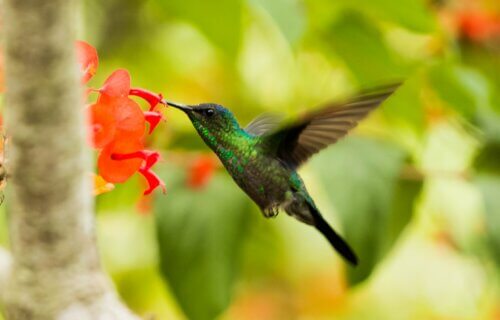BERKELEY, Calif. — Bees are not the only ones with a buzz. New research finds hummingbirds are getting “tipsy” off of the alcohol present in nectar-filled flowers and sugar water in bird feeders. A team from the University of California-Berkeley explains that fermentation is a process that converts sugar into alcohol when yeast is present. Yeasts are a type of fungus that eat sugar and produce ethanol and carbon dioxide as byproducts. Nectar-filled flowers are also a good place for yeast and other bacteria that consume sugar to fester and create alcohol.
Does this mean all hummingbirds are flying while drunk? Do they prefer going to food sources that smell like alcohol? If nectar is a staple in their diet, does this also mean alcohol is too? These questions encouraged researchers to explore how much alcohol the average hummingbird actually drinks.
“Hummingbirds are eating 80% of their body mass a day in nectar,” says study author Robert Dudley, a UC Berkeley professor of integrative biology, in a university release. “Most of it is water and the remainder sugar. But even if there are very low concentrations of ethanol, that volumetric consumption would yield a high dosage of ethanol, if it were out there. Maybe, with feeders, we’re not only farming hummingbirds, we’re providing a seat at the bar every time they come in.”
The COVID-19 pandemic made it difficult to answer these questions at first since researchers could not travel to Central America and Africa where there are tons of nectar-feeding sunbirds. Instead, Dudley had his students put alcohol in the sugar water feeder outside his office window to see if the added alcohol was a turn-on or turn-off. The three hummingbirds they observed were male Anna’s hummingbirds that are native to the Bay Area.

Hummingbirds were more than happy to lap up the alcoholic sugar water — containing one percent alcohol by volume — and found it just as enticing as plain sugar water. However, these birds seem to only look for a buzz rather than being full-on drunk. Hummingbirds drank half as much water when the sugar water contained two percent alcohol.
“They’re consuming the same total amount of ethanol, they’re just reducing the volume of the ingested 2% solution. So that was really interesting,” Dudley explains. “That was a kind of a threshold effect and suggested to us that whatever’s out there in the real world, it’s probably not exceeding 1.5%.”
After two weeks of being on the feeder, the authors measured the alcohol level in sugar water. They found a much lower concentration at 0.05 percent by volume.
“Now, 0.05% just doesn’t sound like much, and it’s not. But again, if you’re eating 80% of your body weight a day, at .05% of ethanol you’re getting a substantial load of ethanol relative to your body mass,” Dudley continues. “So it’s all consistent with the idea that there’s a natural, chronic exposure to physiologically significant levels of ethanol derived from this nutritional source.”
Since hummingbirds have great metabolism, it’s possible they burn the alcohol and sugar so quickly they are not getting completely wasted. The new study also shows that birds are likely eating alcohol produced from natural fermentation. Other studies have recorded alcohol levels as high as 3.8 percent by volume in nectar.
“This is the first demonstration of ethanol consumption by birds, quote, in the wild. I’ll use that phrase cautiously because it’s a lab experiment and feeder measurement,” Dudley adds. “But the linkage with the natural flowers is obvious. This just demonstrates that nectar-feeding birds, not just nectar-feeding mammals, not just fruit-eating animals, are all potentially exposed to ethanol as a natural part of their diet.”
The next step is to measure how much alcohol is naturally found in flowers and how much birds are actually sipping. Beyond hummingbirds, Dudley plans to observe the behavior of other nectar-eating birds such as Old World sunbirds and honeyeaters in Australia.
The study is published in the journal Royal Society Open Science.
You might also be interested in:
- Best Of The Best Bird Feeders In 2023: Top 5 Products Most Recommended By Experts
- Hummingbirds could go extinct as they move to escape global warming, study says
- Hangover-free drinking? New probiotic may protect against painful side-effects of alcohol
- ‘Drunken monkey theory’ suggests humans inherited a taste for alcohol from primates

